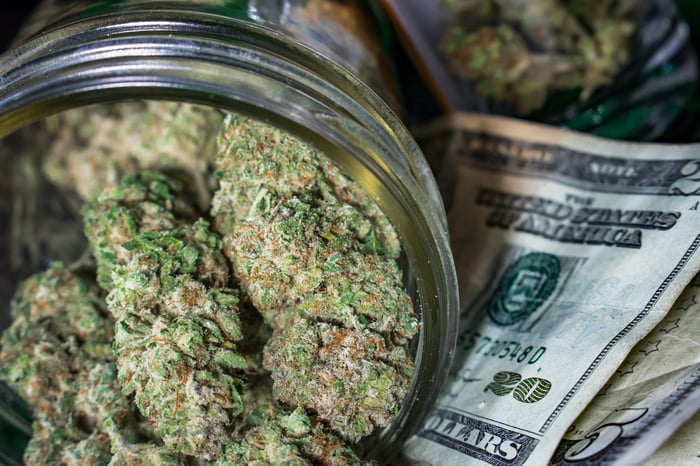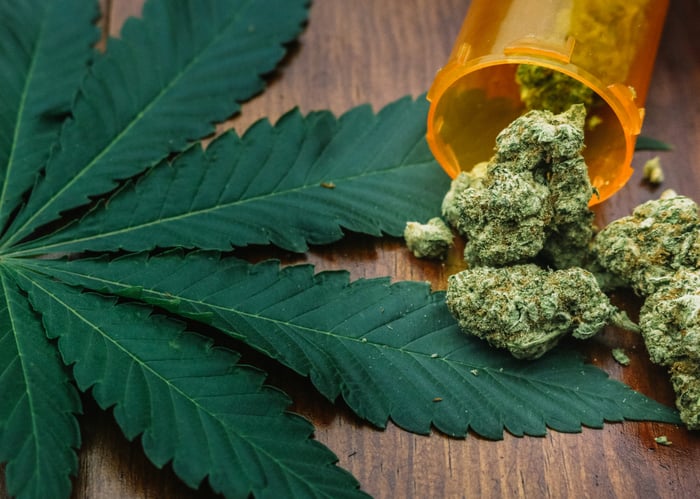The "green rush" has fully gripped Wall Street and investors. Even with a recent pullback, many of the largest publicly traded marijuana stocks by market cap have seen their share prices soar by more than 1,000% over the trailing-two-year period.
Instrumental to this surge in pot-stock market caps is a steady shift in the way the public views the drug. Gone are the days where cannabis was considered too taboo for discussion. Instead, politicians regularly discuss their views on marijuana while on the campaign trail, and parents freely talk about cannabis with their children. Within the U.S., national pollster Gallup notes that almost two-thirds of all respondents in its October 2017 poll favored the idea of legalizing weed. That's up 39 percentage points from where support stood for legalization in 1995.

Image source: Getty Images.
It's also a market that's expected to see continued robust sales growth. ArcView pegged North American legal-weed growth at 33% last year, to $9.7 billion, and it's forecasted $47 billion in annual sales in a decade's time. Yet even this aggressive estimate may undercut the true potential of the cannabis industry.
The marijuana industry could be much bigger than you realize
According to a new note published this past week by investment firm Cowen (COWN), the total cannabis market could generate as much as $75 billion in gross annual sales by 2030, up from a previous forecast of $50 billion by 2026.
The investment bank's initial forecast was released in September 2016 via a 110-page report from beverage, tobacco, and cannabis sector analyst Vivien Azer and her team. The report, "The Cannabis Compendium: Cross-Sector Views on a Budding Industry," highlighted the many potential applications of legal cannabis and outlined pathways that would allow the weed industry to reach $50 billion in sales by 2026. Chief to that thesis is the expected legalization of marijuana in the U.S. at some point before 2026.
The investment bank's new note lifts its projected sales estimate by another 50% ($25 billion), while adding on just four additional years. Cowen offered six reasons behind its decision to become even more bullish on the outlook for marijuana. Chief among them was proprietary data on binge-drinking statistics among U.S. states that showed a notable decline in binge drinking below the national average in states that had legalized cannabis. It's Cowen's assumption that as more states legalize pot, binge-drinking rates would be expected to fall as consumers opt for cannabis in place of alcohol.

Image source: Getty Images.
Additionally, Cowen finds that the cannabis market is already worth about $50 billion, albeit with black-market channels being accounted for. If you factor in per-capita spending of $1,500 a year, 50% higher than it previously forecast, along with 35 million annual cannabis users, you can see where the bulk of this $25 billion annual increase from its 2016 projections is coming from.
Cowen even suggests that the United States' fight against the opioid epidemic could lead to an increase in cannabis consumption. Per the report, "Newly published research reinforces the work that we have already done, showing that for some, cannabis is an effective opioid substitute (in particular in treating chronic pain)."
Three industries Cowen believes will benefit from the green rush
More importantly, upping its annual sales forecast for the cannabis industry to $75 billion by 2030 suggests that there should be direct and indirect winners associated with this green rush. In particular, between its 2016 and 2018 note, three industries stand out.
First, we have the growers. Of course, Cowen is pretty particular about the growers it prefers, with market-outperform ratings saved for Canopy Growth Corp. (CGC -4.01%) and MedReleaf (NASDAQOTH: MEDFF).
Canopy Growth has growing facilities being constructed on 3.7 million square feet of land in British Columbia, which may wind up pushing its fully funded annual capacity over 300,000 kilograms. Canopy also has the most enviable distribution channels of any pot stock, with physical retail outlets, online sales, the most recognizable brand name in Canada (Tweed), and spirits-giant Constellation Brands as a minority owner and project partner.

Image source: Getty Images.
Meanwhile, MedReleaf has stated that its fully funded capacity is 140,000 kilograms annually. Despite producing less than Canopy, MedReleaf is far more focused on extracts and oils than many of its peers. These products carry higher price points and significantly better margins, which should allow MedReleaf's margins to be higher than most growers.
Secondly, Cowen has shown favorability toward packaging and marketing companies -- and more specifically, Kush Bottles (KSHB). Following the release of strict packaging and labeling requirements for recreational cannabis from Health Canada, it only makes sense that Kush Bottles, which works with thousands of growers, could play a key role in helping these producers maintain compliance. Kush was also the top-performing pot stock during the first quarter, gaining 22%.
Finally, in 2016, Cowen suggested that quick-service restaurants stood to see an uptick in business. Cannabis use is well-known to cause "the munchies," which makes quick-serve establishments the perfect solution for hungry pot smokers.
Two factors that could thwart Cowen's utopian view on pot
However, investors must understand that a lot needs to go right in order for Cowen's utopian sales estimate to come to fruition. There are, in particular, two events that could thwart its aggressive 2030 sales estimate.

Image source: Getty Images.
To begin with, there are concerns about oversupply. To be fair, no developed country has ever legalized recreational weed before, so no one, from Wall Street to retail investors, has the faintest idea what the supply-and-demand picture might look like once all growers are fully ramped up. But based on production estimates, issued licenses, and demand estimates, it's looking quite possible that by 2020 or 2021, Canada could be producing 600,000 kilograms to 1 million kilograms a year above domestic demand. Some of this oversupply could be exported to foreign markets that have legalized medical cannabis, but it's unclear if exports would account for the entirety of the oversupply -- should an oversupply even exist in the first place.
The other big question mark is what will happen in the United States. Polling suggests that the public is in favor of legalization. However, Capitol Hill hasn't been willing to budge on cannabis until additional medical research on its risks and benefits is conducted -- research, mind you, that's held up by the red tape associated with its Schedule I classification.
What's more, Attorney General Jeff Sessions appears hell-bent on stopping the state-level expansion of cannabis as long as he's in charge of the Justice Department. While it's not out of the question that the U.S. changes marijuana's scheduling at the federal level, it looks unlikely to happen with Sessions and/or President Trump in office.
Only time will tell if Cowen is a cannabis visionary or overly optimistic.





